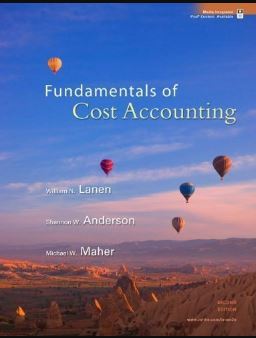
Fundamentals of Cost Accounting 2nd Edition by William Lanen, Carolyn Wells, Michael Maher
Edition 2ISBN: 978-0077274993
Fundamentals of Cost Accounting 2nd Edition by William Lanen, Carolyn Wells, Michael Maher
Edition 2ISBN: 978-0077274993 Exercise 35
Interpretation of Regression Results: Multiple Choice
Cortez Company is planning to introduce a new product that will sell for $96 a unit. The following manufacturing cost estimates have been made on 20,000 units to be produced the first year:

Manufacturing overhead costs have not yet been estimated for the new product, but monthly data on total production and overhead costs for the past 24 months have been analyzed using simple linear regression. The following results were derived from the simple regression and provide the basis for overhead cost estimates for the new product.

Required
a. What percentage of the variation in overhead costs is explained by the independent variable
(1) 92.1%.
(2) 45.0%.
(3) 84.8%.
(4) 8.48%.
(5) Some other amount.
b. What is the total overhead cost for an estimated activity level of 50,000 direct labor-hours
(1) $370,000.
(2) $120,000.
(3) $250,000.
(4) $320,000.
(5) Some other amount.
c. How much is the variable manufacturing cost per unit, using the variable overhead estimated by the regression (assuming that direct materials and direct labor are variable costs)
(1) $88.00.
(2) $82.00.
(3) $86.80.
(4) $72.00.
(5) Some other amount.
d. What is the expected contribution margin per unit to be earned during the first year on 20,000 units of the new product (Assume that all marketing and administrative costs are fixed.)
(1) $96.
(2) $24.
(3) $56.
(4) $14.
(5) Some other amount.
e. What is the manufacturing cost equation implied by these results
(1) Total cost = $640,000 + $5.00 × Number of units.
(2) Total cost = $120,000 + $86.80 × Number of units.
(3) Total cost = $120,000 + $72.00 × Number of units.
(4) Some other equation.
Cortez Company is planning to introduce a new product that will sell for $96 a unit. The following manufacturing cost estimates have been made on 20,000 units to be produced the first year:

Manufacturing overhead costs have not yet been estimated for the new product, but monthly data on total production and overhead costs for the past 24 months have been analyzed using simple linear regression. The following results were derived from the simple regression and provide the basis for overhead cost estimates for the new product.

Required
a. What percentage of the variation in overhead costs is explained by the independent variable
(1) 92.1%.
(2) 45.0%.
(3) 84.8%.
(4) 8.48%.
(5) Some other amount.
b. What is the total overhead cost for an estimated activity level of 50,000 direct labor-hours
(1) $370,000.
(2) $120,000.
(3) $250,000.
(4) $320,000.
(5) Some other amount.
c. How much is the variable manufacturing cost per unit, using the variable overhead estimated by the regression (assuming that direct materials and direct labor are variable costs)
(1) $88.00.
(2) $82.00.
(3) $86.80.
(4) $72.00.
(5) Some other amount.
d. What is the expected contribution margin per unit to be earned during the first year on 20,000 units of the new product (Assume that all marketing and administrative costs are fixed.)
(1) $96.
(2) $24.
(3) $56.
(4) $14.
(5) Some other amount.
e. What is the manufacturing cost equation implied by these results
(1) Total cost = $640,000 + $5.00 × Number of units.
(2) Total cost = $120,000 + $86.80 × Number of units.
(3) Total cost = $120,000 + $72.00 × Number of units.
(4) Some other equation.
Explanation
a.
To calculate percentage of the varia...
Fundamentals of Cost Accounting 2nd Edition by William Lanen, Carolyn Wells, Michael Maher
Why don’t you like this exercise?
Other Minimum 8 character and maximum 255 character
Character 255


